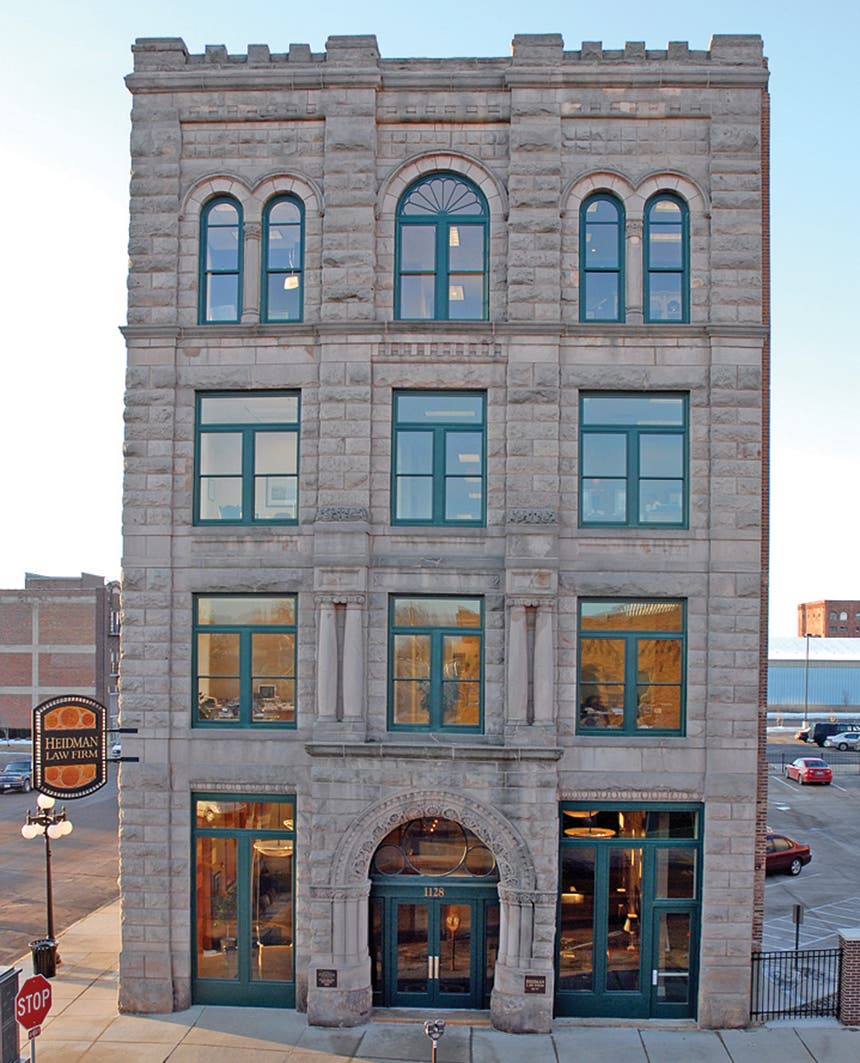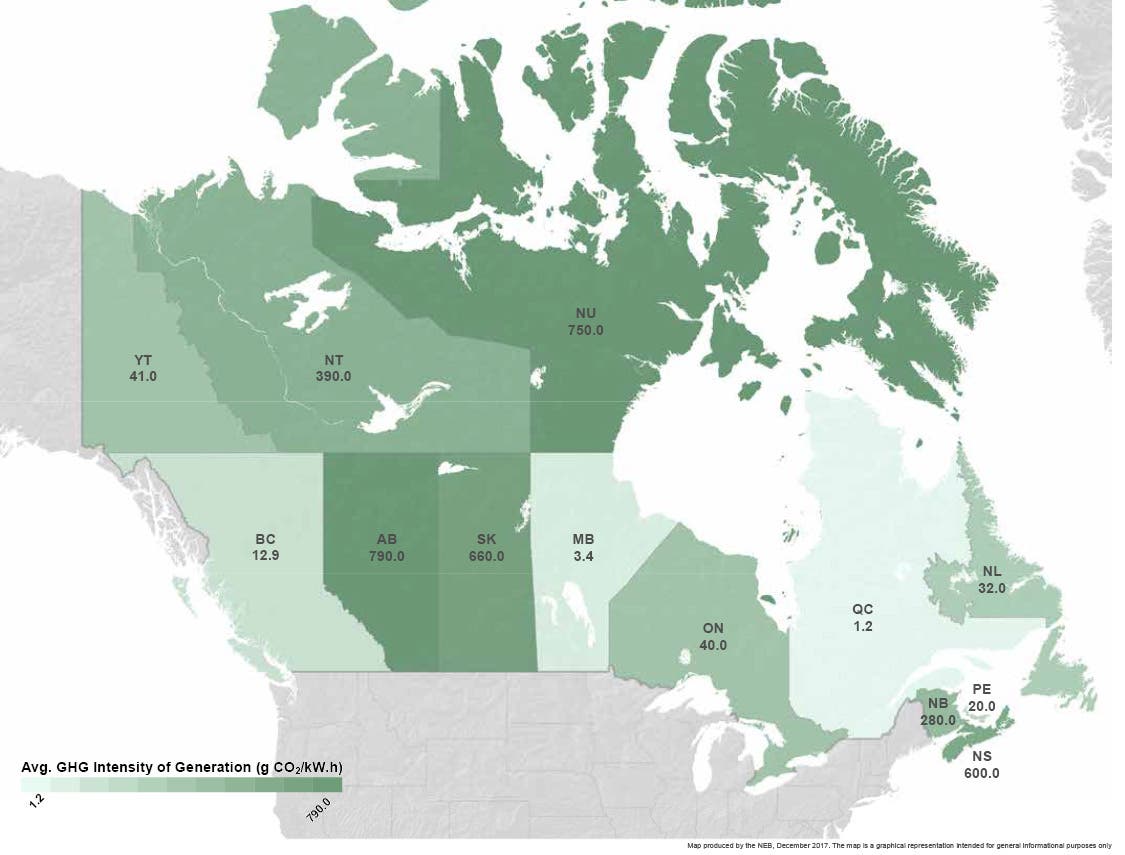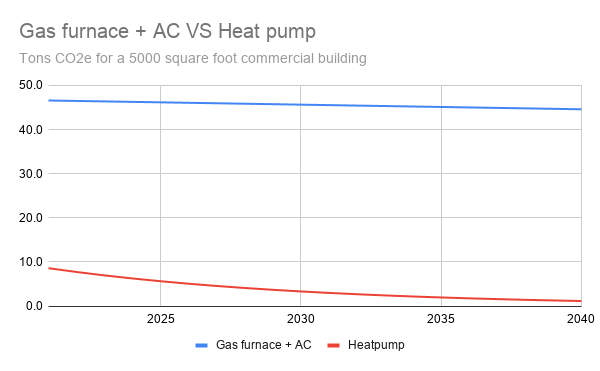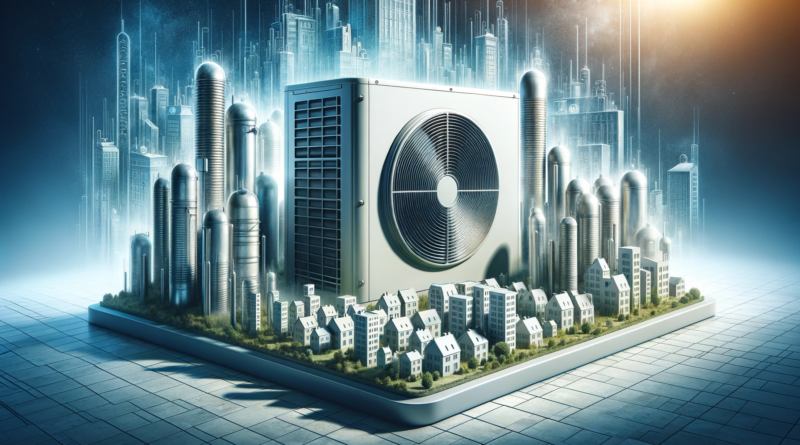One Change To The Worst Buildings Would Have Big Climate Benefits & Cut Costs
There are almost 500,000 commercial buildings in Canada, and about ten times as many in the United States. The median size of these buildings is only 5,000 square feet, or about about 465 square meters. And the worst 10% of them are leaky, have natural gas furnaces that belch carbon dioxide, and have old air conditioners which leak refrigerants that are absolutely nasty in terms of global warming potential.

How nasty? Well, that’s a bit of a story. And as for what one thing will solve a huge portion of the problems, you’ll have to wait for that.
Let’s start with the several sources of greenhouse gas emissions from buildings, and why some buildings are a lot worse than others.
Some Buildings Leak Energy More Than Others
The first is that some buildings are just really drafty. They leak. They have poorly fitted doors and windows, cracks in the walls, and holes in the roof. This is something that building efficiency experts measure with positive pressure tests. They seal up the intentional holes in the building envelope required for ventilation systems, they set up a big blower in a doorway, then they pump a lot of air in at 50 pascals or 75 pascals depending on whether it’s a residential or commercial building. Based on how much air escapes, they can determine the air changes per hour or the liters per second per square meter (lps/m2) of air that escapes. The more air escapes, the leakier the building is. The more warm or cool air escapes to the outside, the more energy is required to heat and cool the building.
Making buildings a lot less leaky has been a huge effort for the building industry and efficiency programs for decades, but that’s not where this assessment is going. The most efficient commercial buildings are down in the range of 2 lps/m2. The median per a study referenced below is 6.9 lps/m2. The average of the worst buildings was 30 lps/m2. That means that over four times as much air — and hence heating and cooling energy — escapes from those bad buildings as from the median ones, and 15 times as much as the good ones. That’s a big deal, because that energy has to come from somewhere.
For the worst 10% of buildings, that somewhere is natural gas for heat, and grid electricity for air conditioning. And the air conditioners are old, leakier than average, and have high global warming potential (GWP) refrigerants, instead of the new ones the Kigali Amendment is driving through the industry. Let’s tear these apart, one by one.
“Natural” Gas Is A Real Problem
The first thing to know about natural gas is that it’s mostly methane, CH4, which is to say one carbon atom and four hydrogen atoms. When you burn methane, the carbon binds with oxygen in the atmosphere to form carbon dioxide (CO2), and the hydrogen binds with oxygen to form water vapor (H2O). The latter isn’t a problem, but the first is. Carbon has an atomic weight of 12 while oxygen has an atomic weight of 16, which means every carbon molecule in natural gas turns into a molecule that has an atomic weight of 44, which is 3.7 times the mass of the original carbon. Basically, that means you end up, after throwing away the 10% of natural gas which is random other chemicals that in some cases don’t even burn, about twice the mass of carbon dioxide as in the original natural gas.
The second thing to know about the 90% of methane in natural gas is that it’s actually a much stronger greenhouse gas than carbon dioxide. Over 100 years, methane creates 28-26 times as much warming as an equivalent mass of carbon dioxide. And methane leaks out of the wells that it’s drilled from and from the pipes that transmit it. That’s all factored down to carbon dioxide equivalent or CO2e. That helps analysts do apples-to-apples comparisons between different greenhouse gases.
The third thing to know about natural gas is that it takes energy to extract it, refine it, and distribute it. And guess where most of that energy comes from. That’s right, more fossil fuels being burned, along with electricity, which in many cases is also generated with fossil fuels. Co-generation using natural gas and coal in fossil fuel regions is incredibly common. And once again, burning gas or coal means more carbon dioxide.
The combination of leaking and the energy required is about 20% of the carbon dioxide created when you burn natural gas to heat a building per US DOE studies, so we have to uplift the impact by that amount. That means that for every gigajoule of heating from natural gas, 59.4 kg of CO2e are emitted.
Leaky Buildings Burn A Lot Of Natural Gas
But how much natural gas does a 5,000 square foot building consume to heat itself? For that I turned to a study by Natural Resources Canada of annual energy usage by buildings in different regions across the country.

A 2015 paper by Diana Ürge-Vorsatza and co-authors in Renewable and Sustainable Energy Reviews indicated that 38% of energy consumption in buildings was for heating, and 8% for cooling, on average. For one of those leaky buildings, they would consume about 690 GJ of natural gas for heating, which means that factor alone turns into about 45 metric tons of CO2e.
That’s a lot. And it’s for a small commercial building, one of those unassuming old office buildings that’s spread everywhere through North America.
Air Conditioning Has Different Problems
First off, air conditioning does use energy, but electricity. The Canadian average is 140 grams CO2/kWh, but it varies wildly across the country. Alberta’s fossil-fuel heavy generation, for example, is closer to 800 grams CO2/kWh, while hydroelectric-heavy BC and Quebec are much lower, along with nuclear-heavy Ontario.

The 8% of energy used for cooling in buildings turns into just over a MWh of electricity used for air conditioning in the leakiest 5,000 square foot buildings. That’s another 145 kg of CO2e on the pile.
But that’s not the big hitter for air conditioning. The larger problem is leaking refrigerants. The industry average is 3% leakage per year, but older systems leak more, so I used 6%. Various HVAC sources provided the rules of thumb that indicated that this leaky, old building with probably 25 occupants and 20 windows or so would require about 12.5 tons of air conditioning. Fun fact: air conditioning is measured by the amount of energy required to melt one Imperial ton of Hudson River water ice in 24 hours. The 12.5 tons of air conditioning require about 17 kg of refrigerants. 6% per year means about about kilogram of refrigerant loss per year.
Doesn’t sound like much, does it? Except for the problem that refrigerants often have very high global warming potentials, thousands of times higher than CO2. The most common commercial air conditioning refrigerant is an HFC labeled R134a, and it has a GWP of 1,430. Another, less commonly used HFC refrigerant has a GWP of 14,900. That one kilogram of R134a is roughly equivalent to 1,430 kilograms of CO2.
Another fun fact: global warming from refrigerants would be worse if it weren’t for the hole in the ozone layer. The Montreal Protocol which the Kigali Amendment is amending replaced ozone-destroying CFC refrigerants with HFCs. As an unexpected side effect, HFCs have a slightly lower GWP than CFCs, so more global warming would have been attributable to cooling than already is. I haven’t looked, but I’m sure some nerd like me was bouncing up and down pointing out the still high GWP of HFCs when the Montreal Protocol was being hammered out, but was ignored.
The combination of energy use and refrigerant leakage means that small old building has another 1.5 metric tons of CO2e emissions per year. That’s a total of close to 47 metric tons of CO2e between heating and cooling.
So What Is The One Change?
As pointed out earlier, most of the focus over the past decades has been to make buildings less leaky, and that’s a good thing. Efficiency helps. But you can’t turn a 30 lps/m2 building into a 2 lps/m2 building. You can probably get it down near the median with a lot of work and good consultants and contractors. It would take a myriad of small changes, including replacing all the windows most likely. But there is one change that could be done that would drastically cut emissions, and building operating costs as well.
Put in a heat pump system.
Heat pumps exchange heat between the inside of the building and the outside. They don’t care whether they are pulling heat in or pushing heat out. They are both heating and cooling systems. They replace both the gas furnace and the air conditioner. Because they are moving heat, not creating it, they are much more energy efficient than gas furnaces, with a coefficient of performance (COP) that’s an average of 3.5, which means that they provide 3.5 more heat energy than the energy required to power them, unlike natural gas boiler units which have an absolute limit on COP of 1, but typically are running 0.85. Yes, heat pumps require four times less energy to produce the same amount of heat to a building.
Heat pumps run on electricity, not natural gas. Modern heat pumps are charged with Kigali Amendment approved HFCs with GWPs in the range of 8, not 1,430. Modern heat pumps leak less refrigerants too.
All of the heating and cooling requirements of our old leaky building turn into about 8.4 metric tons of CO2e from heating and about 0.15 metric tons CO2e from cooling. That’s over 5 times lower emissions with a heat pump than the systems it replaced, with absolutely no other changes to the building or to heating or air conditioning use.
The kicker on this, of course, is that the grid is decarbonizing. The numbers above only get better. Natural gas has the opportunity to reduce a fraction of the 20% of upstream and midstream emissions, but there is no opportunity to reduce the emissions cost of burning it for heat in buildings. Air conditioning’s major burden is from refrigerants, so only the electricity CO2e intensity will assist it. As more renewables enter grids, electricity’s carbon burden plummets. The province of Quebec, with its massive northern hydroelectric project and 4 GW of wind energy, has a grid carbon load of 1.2 grams of CO2e per kWh, two orders of magnitude less than the Canadian average.

When every grid gets down there, heat pumps aren’t 5 times better than current systems, but 500 times better in terms of emissions. The model above assumes a 10% improvement per year, which implies declining results in later years as the grid improves.
There is a reason why one of the primary solutions to stopping global warming is to “electrify everything.”
And Then There Are The Cost Savings
I promised to talk about cost savings too. Having done the math a couple of times, there are a few factors. First, the vast efficiency improvement of a heat pump over a natural gas system means that even with cheap natural gas and expensive electricity, it’s pretty much a wash. But where there is a carbon price that applies to natural gas, which under Canada’s regulations is trending to $2.50 per gigajoule, the value proposition is very strongly on the side of using electrically powered heat pumps.
But that’s not all. Replacing two capital systems which are nearing end of life with a single system saves direct money in replacement costs. Maintenance for a single system is cheaper than maintenance for two systems. Carbon monoxide detectors can be eliminated. Insurance for gas furnaces is more expensive. The calculations I’ve done suggest that this is tens of thousands of dollars in direct savings for businesses over the life of the system. Anyone considering dealing with end-of-life heating and cooling systems should spend some serious time considering heat pumps over the objections of the vendors who will want to replace existing units with new versions of the same thing.
What Does This Net Out To?
For Canada, there are about 50,000 small, old leaky commercial buildings. Just putting heat pumps in them and doing nothing else would eliminate about 1.9 megatonnes of CO2e per year, and about 38 megatonnes over 20 years. That’s a lot. For context, that one change would be about 1% of Canada’s total GHG emissions reduction target by 2030. And with grid carbon intensity declining every year, the emissions reduction dividend just increases.

Given the United States’ greater supply of buildings in general, that would be closer to 20 megatonnes of CO2e eliminated every year there, and increasing every year. Of course, we can’t deploy 50,000 heat pumps in 12 months in Canada, or 500,000 heat pumps in a year in the US. Or can we?
Note: The piece above has a minor calculation error which understates the benefits of the heat pump initiative by roughly 10%. The actual numbers for Canada are 2.1 megatonnes avoided annually and 42 megatonnes over 20 years.
References
- Why Is Air Conditioner Capacity Measured in Tons?
- https://www.toolkit.bc.ca/sites/default/files/2014_best_practices_methodology_for_quantifying_greenhouse_gas_emissions%20%281%29.pdf
- Overview of Greenhouse Gases | US EPA
- https://www.energy.gov/sites/prod/files/2015/07/f24/QER%20Analysis%20-%20Fuel%20Use%20and%20GHG%20Emissions%20from%20the%20Natural%20Gas%20System%2C%20Sankey%20Diagram%20Methodology_0.pdf
- BSD-040: Airtightness Testing in Large Buildings
- https://www.researchgate.net/publication/284044735_Analysis_of_US_Commercial_Building_Envelope_Air_Leakage_Database_to_Support_Sustainable_Building_Design
- https://www.epa.gov/sites/production/files/2015-07/documents/emission-factors_2014.pdf
- https://www.epa.gov/sites/production/files/documents/RefrigerantUpdates.pdf
- R134a
- Annual leakage rate (%) for the refrigeration/air-con/HVAC
- Potential emission savings from refrigeration and air conditioning systems by using low GWP refrigerants (Journal Article)
- https://portal.fixdrepair.com/blog/air-conditioner-refrigerant-costs/#:~:text=The%20rule%20of%20thumb%20is,the%20specifications%20of%20your%20unit.
- https://www.cer-rec.gc.ca/en/data-analysis/energy-commodities/electricity/report/2017-canadian-renewable-power/canadas-renewable-power-landscape-2017-energy-market-analysis-ghg-emission.html
- Building Stock Results
- How Much Office Space Do I Need? (Calculator & Per Person Standards)
- https://www150.statcan.gc.ca/n1/en/daily-quotidien/160916/dq160916c-eng.pdf?st=yytvOq-y
- Heating and cooling energy trends and drivers in buildings
- #EC2019 Part 3: Is Building Energy Efficiency Overrated?
- Refrigerant Management @ProjectDrawdown #ClimateSolutions
- The Short List Of Climate Actions That Will Work
Have a tip for CleanTechnica? Want to advertise? Want to suggest a guest for our CleanTech Talk podcast? Contact us here.
Latest CleanTechnica.TV Video

CleanTechnica uses affiliate links. See our policy here.

